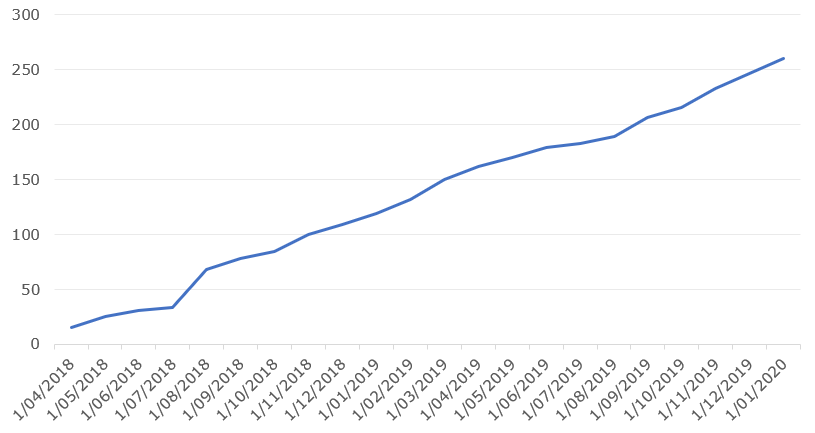We posted late last year on our upcoming “summer of QGIS training”, and thought it might be interesting to review of our QGIS training and materials. So, over the Christmas break we looked at where we are at with our freely available online training materials. I was pleasantly surprised to find how far these resources have spread across the globe, as you can see from our dynamic map below. We keep this up to date as people request access to the free material (so, in the future this post won’t make much sense as the map below will be covered in dots!).
Firstly, while we haven’t had a massive number of requests, demand is steady. In December, we crossed the 250 request mark, and you can see how this has increased over time by looking at the graph below.

We do store some very basic information against each request, and we’ve started asking for two main things – ‘what country do you live in?’ and ‘what industry do you work in?’. So, where in the world is the demand for this? We have the points above, but let’s do a quick snapshot view of it by country…

Even though we only have a few hundred responses, use comes from both developed and developing countries, implying that QGIS provides value for all sorts of organisations. Our word-of-mouth and marketing approach has been very Australian-centric to date (with an obvious smattering of people finding us via search engines), but the majority of our requesters come from Australia.
But, who are all these people? Well, that’s much harder to say for a couple of reasons; while we have a range of people who were willing to let us know which industry they were in, a large number of them joined up before the additional ‘which industry are you in’ question was added – so over half (51%) are actually unknown. We ended up using a fairly commonplace list of industry terms, as you can see from the chart below.

Unsurprisingly, especially since our course was originally titled an “environmental QGIS course”, there has been a lot of uptake in the environmental industry sector. There are also some real gems in the emails that we have received about how people want to use QGIS. Some of the reasons people are using our training materials include:
- nature conservation, natural resource management and environmental science across Australia,
- undertaking protected area management and biodiversity conservation in Nepal,
- nature conservation in Croatia, and
- doctors working in the public sector of Myanmar, using it for case mapping.
When we released our training course for free (thanks to support from Project Dieback and South Coast NRM), these are exactly the sort of people we wanted to help out.
In more recent times, I’ve been also talking to the technical team behind QGIS and the documentation component in particular. My recent discussions with that team around documentation seemed to focus on Git repositories, APIs and Python code, which might be useful for developers but doesn’t provide any value to a doctor in a developing country trying to work out where the disease they are treating is spreading and how to get on top of it. I strongly believe that the QGIS team needs to focus documentation on the groups that use it – or, to use a dirty phrase that many technical people don’t want to hear – be customer-focused. If focus and attention are taken away from these customers, then the project will cease to be useful to people and it will decline through lack of demand.
I do think that QGIS is one of the best spatial packages out there (for both closed or open source) but unless there is a focus on customers, that won’t continue. So to attempt to help prevent this, we’ll shortly be releasing our new series of QGIS videos, data package and training manual, against the current long-term version of QGIS (3.4), so stay tuned for that. We’re also running multiple training courses this month – a couple of custom ones for organisations that are using QGIS as part of their enterprise spatial systems, and another “open call” one that has already gathered support from a range of organisations that are sending along their staff.
We’ll keep working to make sure that open-source software, like QGIS, can deliver really effective value across a wide range of organisations, in a very practical and pragmatic sense. It’s great to think that we can make a difference like this.
If you’re interested in QGIS, or want to get hold of our training materials, then drop us a line at training@gaiaresources.com.au – and don’t forget you can keep in touch with us via Facebook, Twitter or LinkedIn.
Piers

Comments are closed.